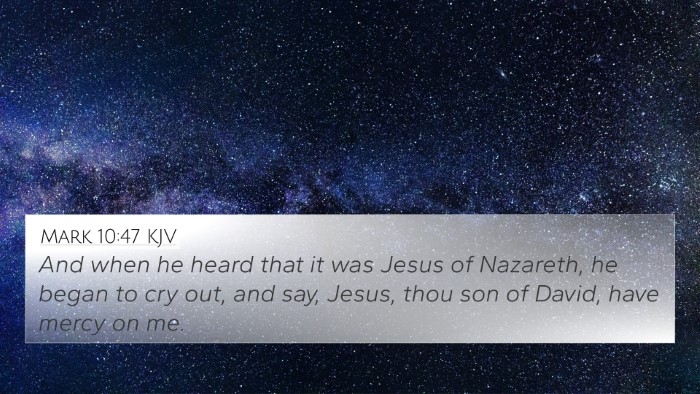Bible Verse Meaning: Matthew 15:23
Verse Text: "But he answered her not a word. And his disciples came and besought him, saying, Send her away; for she crieth after us."
This verse occurs in the context of Jesus’ ministry, where He is approached by a Canaanite woman who seeks healing for her demon-possessed daughter. The verse emphasizes both the initial silence of Jesus and the reaction of His disciples. Below, we explore various insights derived from public domain commentaries, focusing on the thematic connections present within Scripture.
Commentary Insights
-
Matthew Henry:
Henry notes the significance of the woman's persistence despite initial rejection. He reflects on the importance of faith and the testing that can occur in the life of believers. The silence of Jesus, interpreted as a form of testing, leads to a deeper revelation of faith in the woman.
-
Albert Barnes:
Barnes emphasizes that Jesus' reluctance to initially respond highlights His mission to Israel. He explains this as a way to illustrate the broader scope of God's mercy which ultimately extends to the Gentiles through faith.
-
Adam Clarke:
Clarke points out the cultural context in which this interaction takes place. The disciples’ request for Jesus to send the woman away reflects the societal norms of the time, which often excluded Gentiles from receiving God's blessings.
Thematic Connections
Matthew 15:23 touches on several broader themes in Scripture, highlighting connections between various Bible verses:
-
Faith in Adversity:
Similar to Hebrews 11:6, which emphasizes that faith is crucial to please God. The woman’s faith, proved through her persistent cries, illustrates the active engagement required in faith.
-
God's Mercy:
The verse relates to Luke 18:1-8, the parable of the unjust judge, where persistence pays off. The Canaanite woman's persistence is rewarded with Jesus’ eventual acknowledgment.
-
The Role of Discipleship:
This passage connects to Matthew 28:19, where Jesus commissions His disciples to make disciples of all nations, foreshadowing the inclusion of Gentiles into the faith.
-
Need for Intercession:
Similar to the theme in James 5:16, where the prayers of a righteous person can accomplish much, the woman's cry indicates the power of intercession.
-
God's Plan for All Nations:
This points to Isaiah 56:7, where the Lord states His house shall be a house of prayer for all nations, indicating a prophetic vision of inclusion that is realized in the New Testament.
-
Divine Silence:
Related to Psalm 22:1, where the cry of abandonment resonates. Jesus’ silence here serves a purpose, leading to greater understanding of faith and revelation.
-
Testing of Faith:
This connects with 1 Peter 1:7, indicating how trials (or silence in moments of need) refine faith, prompting believers to cling closer to God.
Cross-References and Parallels
Understanding Matthew 15:23 through the lens of associated scripture enhances the depth of meaning. Here are a few key cross-references:
- Mark 7:26 - The account of the Syrophoenician woman highlights cultural barriers and faith.
- Luke 13:28-30 - Discusses the inclusion of those who may be seen as outsiders in the kingdom of heaven.
- Romans 2:10-11 - Affirms that glory, honor, and peace come to everyone who does good, regardless of their ethnic background.
- Galatians 3:28 - This verse establishes that in Christ, there is neither Jew nor Gentile, emphasizing equality in faith.
- John 4:9 - The interaction between Jesus and the Samaritan woman shows Jesus breaking societal norms to demonstrate God's love.
- Acts 10:34-35 - Peter realizes that God shows no favoritism, affirming the theme of divine acceptance beyond ethnic lines.
- Matthew 9:36 - Jesus had compassion on the crowds, echoing the core of His ministry which this woman's plea embodies.
Conclusion
The verse Matthew 15:23 serves as a powerful reminder of the persistence required in faith, the inclusivity of God’s love, and the significance of understanding Scripture through a thematic lens. The insights from various biblical commentaries coupled with supportive cross-references illuminate the depth of this passage. By exploring these connections through methods of cross-referencing, we gain a richer understanding of the Scriptures as a whole.








